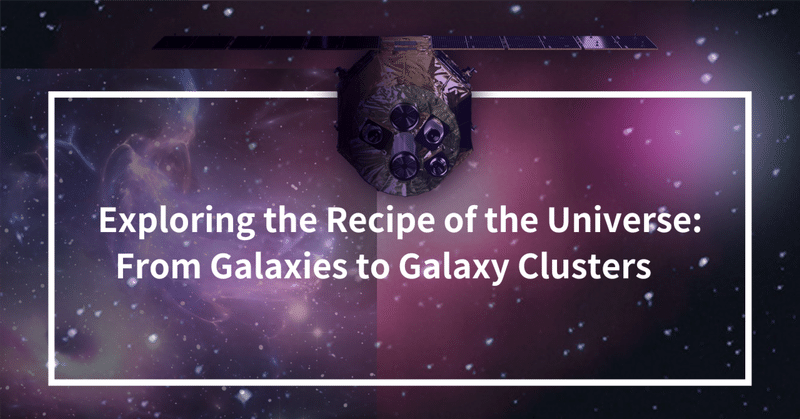
Exploring the Recipe of the Universe: From Galaxies to Galaxy Clusters
One of the fundamental aspects we explore is the synthesis of elements in the universe, which primarily occurs through the explosive demise of stars. As stars explode, they scatter their newly synthesized elements into space. These elements become incorporated into newly formed stars within their galaxy. However, not all elements remain within the confines of their birthplace.
Galaxies, the birth and death sites of stars, are composed of gas, dust, and stars. During a star's death, its synthesized elements are dispersed into the surrounding space. The Milky Way, our home galaxy, is just one of many galaxies in the vast universe.
Beyond individual galaxies lies an even larger entity known as a galaxy cluster. Galaxy clusters consist of multiple galaxies, and the space between these galaxies is filled with gas-emitting X-rays. The high-temperature gas within galaxy clusters is held in place by the immense gravitational force exerted by the significant amount of dark matter associated with the cluster.
Interestingly, the observation of emission lines from highly ionized iron in the X-ray spectra of galaxy clusters was unexpected. These emission lines indicate that the gas within the cluster reaches temperatures of tens of millions of degrees Celsius and contains a substantial amount of iron.
The presence of a significant amount of iron in the cluster gas suggests that numerous elements formed in galaxies' stars have exceeded their gravitational bounds and escaped into the galaxy cluster. This phenomenon implies that galaxy cluster gas has accumulated many elements synthesized by stars since the universe's birth.

Figure 1 illustrates the spectrum of the Perseus cluster of galaxies, combining X-ray and visible light images observed by the Suzaku satellite (yellow: CCD) and ASTRO-H (white: microcalorimeter). The microcalorimeter on ASTRO-H yields spectra with much higher energy resolution compared to the standard CCD detectors used on previous X-ray astronomy satellites.
Apart from intrinsic X-rays from iron, weak X-rays are also emitted from trace elements like chromium, manganese, and nickel. These elements are primarily synthesized by "Type Ia" supernovae, the explosions of white dwarfs. The observed patterns of elemental abundance offer valuable insights into the existence and characteristics of these supernovae.
Galaxy clusters mainly consist of elliptical or lensing galaxies characterized by their ellipsoidal stellar distribution. In contrast, the Milky Way exhibits a spiral-shaped stellar distribution, setting it apart from the abovementioned types.
There are further distinctions between spiral galaxies and elliptical/lensing galaxies. Spiral galaxies continue to form new stars, encompassing a range of masses, from heavy to light stars, as the heavier stars have shorter lifespans. Conversely, elliptical and lensing galaxies have not recently formed many stars, and most of their stars are light with long lifetimes.
The ASTRO-H observations revealed that the elemental abundance ratio (e.g., silicon, iron, chromium, manganese, and nickel) in the elliptical galaxy is similar to that of the Sun, a star within the Milky Way Galaxy. This surprising discovery suggests that stars have formed and exploded similarly in galaxy clusters and the solar neighborhood, despite the contrasting environments.
The XRISM satellite, currently under development, will obtain spectra in lower energy bands that ASTRO-H could not observe to further investigate the synthesis history of elements in the universe. This data will help estimate the total number of massive stars that existed in the past and provide a deeper understanding of the remnants of stars that have already perished.
The process of elements synthesized by stars being ejected into galaxy cluster space is an intriguing mystery. Typically, stars are held within a galaxy due to the immense gravitational force exerted by dark matter. However, when many new stars form, several massive stars are born, and their short lifespans lead to gravitational collapse supernova explosions. These explosions heat the cold gas between stars and give it enough energy to escape the galaxy's gravity, resulting in galactic winds blowing outward.

Credit: X-ray: NASA/CXC/JHU/D.Strickland;. Optical: NASA/ESA/STScI/AURA/The Hubble Heritage Team;. IR: NASA/JPL-Caltech/Univ. of AZ/C. Engelbracht
The XRISM satellite will measure the velocity of the hot gas emitting X-rays, enabling scientists to determine if the gas can overcome the galaxy's gravity and escape into space.
In conclusion, the data obtained by the XRISM satellite will shed light on various aspects, such as the synthesis of elements in supernova remnants, their dispersion into interstellar space, their escape from galaxies, and their spreading within galaxy clusters. We eagerly anticipate unraveling the mysteries of how elements synthesized within galaxies spread beyond galaxy clusters, and the XRISM satellite plays a pivotal role in this exploration.
Author: Kyoko Matsushita
(This article was translated from Japanese.)
